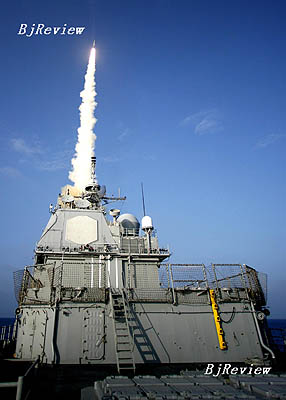|

The U.S. Navy destroyed a failed spy satellite with a Standard Missile-3 (SM-3) rocket launched from a cruiser on February 20. Deemed as an anti-satellite test, the mission drew worldwide attention.
In late January and early February, U.S. officials announced that a defunct spy satellite could fall to the Earth, and missiles or aircraft-based laser weapons might be used to destroy this satellite.
Anti-missile weapons fall into two categories-"hit to kill" (HTK) weapons and anti-satellite lasers. HTK weapons can be launched from the ground, aircraft or anti-satellite spacecraft. Those fired from the ground and aircraft, called direct ascent anti-satellite weapons, are used to intercept low-orbit satellites. After locating the target with built-in homing devices, they collide with it, destroying it with kinetic force. Those launched from spacecraft are known as co-orbital anti-satellite weapons. They first maneuver into the orbit of the target satellite and then smash it. They are mainly used to destroy high-orbit satellites.
The February test was not the first time that the United States destroyed a satellite. Over the past two decades, it has conducted a number of anti-satellite tests using aircraft-based missiles and ground laser weapons.
The HTK anti-satellite program has a long history. From 1977 to 1988, the United States carried out an anti-satellite program known as the ASAT. ASAT missiles, launched from F-15 jets and consisting of three stages, are designed to intercept low-orbit satellites. Five ASAT tests were conducted from 1984 to 1986, with one failure and four successes. One of the successful tests targeted a real satellite. In this test, conducted on September 13, 1985, an ASAT missile destroyed the Solwind P78-1 satellite, 2 meters in diameter and 850 kg in weight, at an altitude of 464 km.
The U.S. Air Force planned to purchase 112 ASAT missiles to arm 20 F-15A jets. But after the five tests, it was reported that the ASAT program was scrapped in 1988 because of alleged violations of international space conventions. Nevertheless, the U.S. Air Force still keeps several ASAT missiles in its arsenal. Some analysts said the United States turned the ASAT program into a secret when the program was about to succeed. Others said that it might have incorporated ASAT technology into larger programs such as the Strategic Defense Initiative.
The United States defended its February anti-satellite test by saying that the test would be carried out in a responsible manner and would not generate harmful space debris. In effect, the test offered evidence that America's anti-missile and anti-satellite technology has almost matured.
Aegis cruiser-based SM-3 missiles have been successfully used in many anti-missile tests in recent years. Although the United States has not conducted any HTK anti-satellite tests since 1988 because of international pressure, there has been so much talk about the anti-satellite capacity of anti-missile systems. The February test indicated that the United States has never ceased its research on HTK technology. Otherwise, it could not have possibly prepared for this successful test on such short notice. It may be deduced that the United States has been doing research on HTK technology or on the integration of HTK technology with anti-missile technology over the years.
The SM-3 missile may have adopted previously developed anti-satellite technology. For instance, the SM-3 missile was improved to make it more competent for the anti-satellite mission. ASAT technology might have been involved in the improvements.
America's pledge that the test would not produce dangerous space debris is difficult to confirm. At present, the United States is the only country capable of monitoring space worldwide. Russia can monitor the space over its own territory. All other countries are unable to do the same. Neither the United States nor Russia makes data public. Even if the United States had secretly conducted HTK tests before, other countries would not have detected them.
The anti-satellite test provided a telling example of the successful combination of anti-missile and anti-satellite technology. It not only exemplified the fact that anti-missile technology can be used in anti-satellite weapons, but it also showed that America's anti-satellite technology can be put into actual use. It will have profound implications for space security. Russia has expressed serious concern about the test. All space-capable countries will closely follow its aftermath. | 